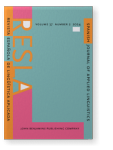Vol. 37:2 (2024) ► pp.553–590
Vol. 37:2 (2024) ► pp.553–590
Interpretación semántica de verbos frasales por aprendientes de inglés como segunda lengua a partir de la posición (dis)continua de sus partículas
Es investigación buscó establecer si los hablantes adultos no nativos de inglés interpretan los verbos frasales aspectuales a partir de la posición continua o discontinua de la partícula que los acompaña y si esto tiene relación con su nivel de dominio de inglés como segunda lengua (L2). Se diseñó una tarea de selección de imágenes que fue aplicada a hablantes adultos nativos y no nativos de inglés, estos últimos fueron divididos en cuatro grupos a partir de sus horas de exposición a la lengua meta (100–200 h, 300–400 h, 600–700 h, +1000 h). Los resultados sugieren que la posición de partícula puede afectar ocasionalmente la interpretación de los verbos frasales de inglés por parte de hablantes no nativos; sin embargo, esto no ocurre de igual manera en todos los verbos frasales, ya que la interpretación está también ligada a la categoría semántica de los verbos frasales y a la partícula presente en cada verbo frasal. Finalmente, los hablantes no nativos de inglés con mayor número de horas de exposición a la lengua meta tienen un desempeño no significativamente diferente al de los hablantes no nativos en la interpretación de verbos frasales, aunque en algunos casos las diferencias son pronunciadas.
Article outline
- 1.Introducción
- 2.Verbos frasales
- 2.1La posición de la partícula
- 3.Verbos frasales y hablantes no nativos de inglés
- 3.1Producción de los verbos frasales
- 3.2Comprensión de los verbos frasales
- 4.El estudio
- 4.1Los sujetos
- 4.1.1Perfil de los sujetos no nativos de inglés
- 4.1.2Perfil de los sujetos nativos de inglés
- 4.2El instrumento
- 4.2.1Reactivos
- 4.2.2Pronominalidad y posición discontinua de la partícula
- 4.3Aplicación de la prueba
- 4.1Los sujetos
- 5.Resultados
- 5.1Verbos frasales composicionales
- 5.2Verbos frasales aspectuales
- 5.2.1 Up
- 5.2.2 Down
- 5.2.3 Off
- 5.2.4 Through
- 5.2.5 Over
- 5.3Verbos frasales no composicionales
- 5.3.1 Out
- 5.3.2 Up
- 6.Discusión
- 7.Conclusiones
- Notas
-
Fuentes consultadas
Article language: Spanish
